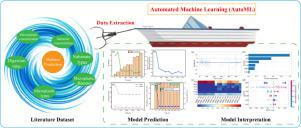Water Research ( IF 12.8 ) Pub Date : 2022-08-14 , DOI: 10.1016/j.watres.2022.118975 Run-Ze Xu 1 , Jia-Shun Cao 1 , Tian Ye 1 , Su-Na Wang 1 , Jing-Yang Luo 1 , Bing-Jie Ni 2 , Fang Fang 1

|
Microplastics as emerging pollutants have been heavily accumulated in the waste activated sludge (WAS) during biological wastewater treatment, which showed significantly diverse impacts on the subsequent anaerobic sludge digestion for methane production. However, a robust modeling approach for predicting and unveiling the complex effects of accumulated microplastics within WAS on methane production is still missing. In this study, four automated machine learning (AutoML) approach was applied to model the effects of microplastics on anaerobic digestion processes, and integrated explainable analysis was explored to reveal the relationships between key variables (e.g., concentration, type, and size of microplastics) and methane production. The results showed that the gradient boosting machine had better prediction performance (mean squared error (MSE) = 17.0) than common neural networks models (MSE = 58.0), demonstrating that the AutoML algorithms succeeded in predicting the methane production and could select the best machine learning model without human intervention. Explainable analysis results indicated that the variable of microplastic types was more important than the variable of microplastic diameter and concentration. The existence of polystyrene was associated with higher methane production, whereas increasing microplastic diameter and concentration both inhibited methane production. This work also provided a novel modeling approach for comprehensively understanding the complex effects of microplastics on methane production, which revealed the dependence relationships between methane production and key variables and may be served as a reference for optimizing operational adjustments in anaerobic digestion processes.
中文翻译:

基于自动机器学习的微塑料预测对厌氧消化中甲烷产生的影响
在生物废水处理过程中,作为新兴污染物的微塑料在废活性污泥 (WAS) 中大量积累,这对随后的厌氧污泥消化以产生甲烷产生了显着的不同影响。然而,用于预测和揭示 WAS 内累积的微塑料对甲烷产生的复杂影响的稳健建模方法仍然缺失。在这项研究中,应用四种自动化机器学习 (AutoML) 方法来模拟微塑料对厌氧消化过程的影响,并探索综合可解释分析以揭示关键变量之间的关系(例如、微塑料的浓度、类型和大小)和甲烷产生。结果表明,梯度提升机的预测性能(均方误差 (MSE) = 17.0)优于普通神经网络模型(MSE = 58.0),表明 AutoML 算法成功地预测了甲烷产量并且可以选择最佳机器无需人工干预的学习模式。可解释的分析结果表明,微塑料类型变量比微塑料直径和浓度变量更重要。聚苯乙烯的存在与较高的甲烷产生有关,而增加微塑料直径和浓度都抑制了甲烷的产生。



























 京公网安备 11010802027423号
京公网安备 11010802027423号